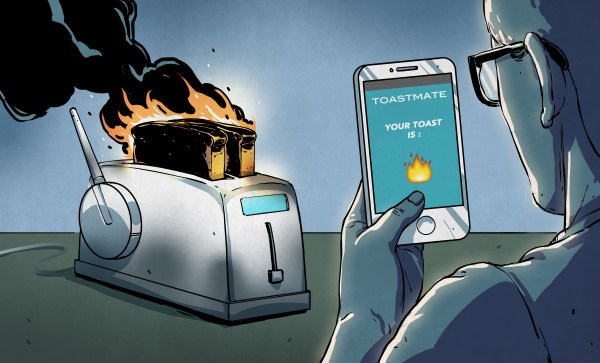More than one hundred years ago, Henri Becquerel discovered that uranium emitted penetrating rays similar to those used by Wilhelm Röntgen to take the first X-ray image (of his wife’s hand), starting a new era of far-reaching applications. There are of course many dangers that come with the use of radioactivity, but there are also many beneficial uses for our society.
Original Art1196 Articles
IuT ! IoT
Let’s build the Internet of USEFUL Things, not just the Internet of Things. IuT ! IoT
That’s what we’ll be doing over the next five weeks. The second challenge of the 2017 Hackaday Prize begins today. We’re looking for the best ideas we can find for useful connected devices. Twenty entries will recieve $1,000 and move on to the final round to vie for the top prizes ranging from $5,000 to $50,000.
There is no doubt that the future is connected. It has been our future since the advent of the telegraph, and we’re unarguably becoming more connected at a faster rate. The phone in your hand, pocket, or bag connects you to the bulk of human knowledge. But it doesn’t yet connect you to very many “things”. It won’t be that way for long.
Already we’ve seen cameras (security, baby monitor, and everything in between) appear as some of the earliest connected devices, and they’ve brought with them all of the unintended consequences of poorly secured computer gear connected to the wider Internet. At least remote cameras have a purpose; there have been more than enough product launches for things that don’t. Our go-to counter-example is the Internet-connected toaster which is the topic of our wonderful art from Joe Kim this morning. Who needs to toast remotely? Nobody.
Let’s Invent the IoT
Here is our chance to do it right. How can Internet of Things make life better? What things become more meaningful when added to a network and what does that look like? How do we continue to connect our world while safeguarding privacy and being mindful of security. Finding answers to these questions will lead you to Build Something that Matters.
IoT Security Is Hard: Here’s What You Need To Know
Security for anything you connect to the internet is important. Think of these devices as doorways. They either allow access to services or provides services for someone else. Doorways need to be secure — you wouldn’t leave your door unlocked if you lived in the bad part of a busy city, would you? Every internet connection is the bad part of a busy city. The thing is, building hardware that is connected to the internet is the new hotness these days. So let’s walk through the basics you need to know to start thinking security with your projects.
If you have ever run a server and checked your logs you have probably noticed that there is a lot of automated traffic trying to gain access to your server on a nearly constant basis. An insecure device on a network doesn’t just compromise itself, it presents a risk to all other networked devices too.
The easiest way to secure a device is to turn it off, but lets presume you want it on. There are many things you can do to protect your IoT device. It may seem daunting to begin with but as you start becoming more security conscious things begin to click together a bit like a jigsaw and it becomes a lot easier.
Continue reading “IoT Security Is Hard: Here’s What You Need To Know”
The Surface Area To Volume Ratio Or Why Elephants Have Big Ears
There are very few things that are so far reaching across many different disciplines, ranging from biology to engineering, as is the relation of the surface area to the volume of a body. This is not a law, as Newton’s second one, or a theory as Darwin’s evolution theory. But it has consequences in a diverse set of situations. It explains why cells are the size they are, why some animals have a strange morphology, why flour explodes while wheat grains don’t and many other phenomena that we will explore in this article.
Continue reading “The Surface Area To Volume Ratio Or Why Elephants Have Big Ears”
Victorians And Fiber, Louisville’s Quest For Fast Internet
It was a dark and stormy afternoon, the kind you get on the east side of the country. I was drinking a coffee, sitting in a camping chair in front of my door, and watching like a hawk for the treacherous cable man to show up. This day there would be no escape. There would be no gently rapping the door with a supple sheepskin leather glove before scurrying away for another union mandated coffee break. I was waiting, I was kind of grumpy, and by God today would be the day. Today would be the day that after hours on hold, after three missed appointments, after they lost my records twice; I would get an answer on whether or not they could actually service internet to my apartment. If I was lucky, and the answer was yes, then approximately two to three thousand years later they would run a cable from the telephone pole to my house and I could stop commandeering WiFi from the pizza shop across from me.
It’s important to note that I was in the middle of the city. I wasn’t out in the boonies. Every house on the block but mine had cable. While this is dumb, it begins to make more sense when you dive into the history. Louisville, Kentucky is a strange place. It used to be the gateway to the west. Ships would crawl up its river until they reached the falls. Then porters would charge an exorbitant fee to carry all those goods down to the bottom of the falls where they would be loaded on a ship and be sent ever westward. Resulting in every rich merchant, captain, and manufacturer in the region having a nice house there. Ever wonder why the Derby is in Louisville and the Queen comes to visit sometimes? It probably has something to do with it having the highest concentration of Victorian buildings and mansions outside of New York City.
Continue reading “Victorians And Fiber, Louisville’s Quest For Fast Internet”
Heat Shrink Tubing And The Chemistry Behind Its Magic
There’s a lot to be said in favor of getting kids involved in hacking as young as possible, but there is one thing about working in electronics that I believe is best left as a mystery until at least the teenage years — hide the shrink tube. Teach them to breadboard, have them learn resistor color codes and Ohm’s Law, and even teach them to solder. But don’t you dare let them near the heat shrink tubing. Foolishly reveal that magical stuff to kids, and if there’s a heat source anywhere nearby I guarantee they’ll blow through your entire stock of the expensive stuff the minute you turn your back. Ask me how I know.
I jest, but only partly. There really is something fun about applying heat shrink tubing, and there’s no denying how satisfying a termination can be when it’s hermetically sealed inside that little piece of inexplicably expensive tubing. But how does the stuff even work in the first place?
Continue reading “Heat Shrink Tubing And The Chemistry Behind Its Magic”
Introduction To TensorFlow
I had great fun writing neural network software in the 90s, and I have been anxious to try creating some using TensorFlow.
Google’s machine intelligence framework is the new hotness right now. And when TensorFlow became installable on the Raspberry Pi, working with it became very easy to do. In a short time I made a neural network that counts in binary. So I thought I’d pass on what I’ve learned so far. Hopefully this makes it easier for anyone else who wants to try it, or for anyone who just wants some insight into neural networks.





















